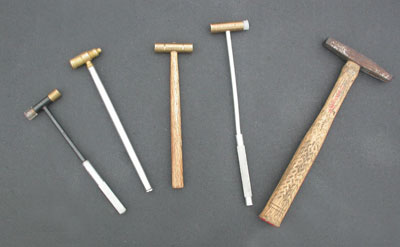Spend time at a boat yard and you will be sure to hear the tap, tap, tap of a marine surveyor. “What are you looking for?” is a question I hear with regularity. At a boat show recently I heard a broker complain about a surveyor who “showed up with a small hammer and tapped everywhere.” Here is why I do it.
Tapping, or percussion testing, is an extremely useful non-destructive inspection technique. Tapping is not limited to boat yards; it is used throughout the world and in many different fields. It is included in the inspection process of stealth technology planes and space shuttles. It provides information that is not available visually and usually causes no damage, except for perhaps a small localized loss of bottom paint.
Its primary use in a boat yard is determining the condition of fiberglass laminates. It is also useful with wood and other construction materials. In fiberglass or composite boats, tapping allows detection of delamination. Fiberglass boats and their component parts, are made of several layers of lamination. Gelcoat, coring and fiberglass material with resin are among the most common types of laminates. A separation or “disbond” can occur at any level. Percussion testing allows detection of separation between the gelcoat and the first fiberglass laminate (skin coat). It can also detect delamination within any of the layers of the fiberglass, including delamination caused by osmosis (blisters) and disbanding of the layers adjacent to the core.
The vast majority of boats are manufactured with a cored deck. Hulls, stringers and other parts may also be cored. Coring is usually balsa, foam or plywood, sandwiched between layers of fiberglass. The fiberglass encasement on either side of the deck coring can delaminate. Thus, percussion testing both the top and bottom of the deck, where accessible, is a useful inspection technique. Fiberglass bulkheads are usually tabbed (fiberglass taped) to the hull sides. Tapping the fiberglass tabbing can determine if the tabbing is properly attached. Occasionally the tabbing does not bond (usually to the plywood bulkheads and I have seen vessels in which the fiberglass tabbing attachments (secondary bonds) were never well made. On a few occasions, this has left virtually all of the bulkheads “adrift” and grossly weakened the hull structure. Properly made tabbing can become detached due to an external force from impact, heavy weather operation or even over tensioning a sailboat’s rigging (usually a backstay).
In vessels that use organic coring material, and there are many, the most type is balsa or plywood. This wooden coring can deteriorate (fungus deterioration or dry/wet rot) and the deteriorated coring can often be detected by tapping. A properly made deck cored with balsa sounds solid and sharp when tapped; if the balsa is deteriorated the same deck sounds soft or dull. Deteriorated coring can also be detected by tapping stringers and transoms, particularly on smaller boats.
Tapping wood boats or wooden components also allow detection of deterioration. Bulkheads are often constructed of plywood which is covered with fiberglass, upholstery or carpet; tapping can reveal secrets that even the owner was unaware of. Occasionally when tapping deteriorated wood, this inspection technique becomes destructive.
Many of the things detected by tapping are minimal including “voids”. Voids are air bubbles trapped just below the gelcoat or skin coat. Tapping a void is distinguishable by the higher pitch. The area around the void will have a lower report than the thin skinned void. The voids are cosmetic and a nuisance occasionally but are rarely ever significant structurally.
The tapping can be done with virtually anything. Depending on the material and thickness of the component which is being tapped variances can be found using a finger nail, edge of a coin, butt of a screw driver or of course the preferred tool, a hammer.
Hammers can be made of bronze, steel, plastic or any hard material. As long as an audible report is made when the device taps the component being inspected. The difference in the sound made is what the surveyor is listening for. I have found metallic hammers give the most discernible reports, but I primarily use plastic hammers above the waterline. If an audible difference is determined I will also tap in the area a second time using a small metal hammer.
Percussion testing should be non-destructive. Occasionally voids will open, paint will flake and small hammer marks are accidentally made. I attempt to leave no indication of my survey and surveyors should be aware of any damage being caused by their percussion testing. One fateful survey began with a hammer becoming lodged in a rotten wooden boat. It was the first tap of that area of the boat and the last tap of that day with a hammer. I kept tapping, but used my finger.
While percussion testing is an excellent use of a non-destructive inspection technique it is but one of many inspection techniques, which are used in the process determining the condition of a vessel. Along with percussion testing many other methods are used in assessing the condition of a laminate. Flexing under foot, visual discoloration or cracks, indentations, crackling sounds when stepped on, concave or convex areas, discoloration are other signs of potential problems. Moisture meters can be used to help assess the condition of laminates and, when necessary, destructive techniques can be employed.
This article was edited on March 1, 2016.